| T O P I C R E V I E W |
| the_mike |
Posted - 11/27/2019 : 09:12:52
On November 16th, I had the opportunity to fly from Zürich (ZRH) to Amsterdam (AMS), and took both my devices with me.
Preparation:
I charged both GMC, and used Geigerlog to set Date&Time and History-Savingmode to CPM.
I did my best to reset the history on the counters at the same time.
For “easy access” at the security-check, I put both counters into a ziplock-bag; to ensure an equal reading, I did so the day before the flight to prevent disturbances within the background-readings.
For the travel, the ziplock-bag containing the counters was stored in my rucksack which I took as hand-luggage.
Taking the measurements:
Traveling to the airport by train, the rucksack with the counters remained next to me, as at the airport.
At the security-check in ZRH, I had to take all electronic devices out of the rucksack.
At the flight to AMS, the rucksack was stored below the frontseat.
In Amsterdam, the counters remained in my rucksack, which was stored at a wardrobe.
AMS security-check used some more modern scanners than ZRH, the devices were allowed to stay inside the rucksack for the scan.
At the flight to ZRH, the rucksack with the counters was stored in the overhead-compartment.
Both flights were carried out by KLM, in Embraer 190.
Data handling:
Both Logs were downloaded on Nov 17th with 0.9.90pre10, on PC1/LinuxMint 18.3
The screenshots were created from history-files using Ullix’ Geigerlog (0.9.93pre4), on PC2/LinuxMint 19.2
Screenshots have been set from 16/11/19 06:00 to 17/11/19 01:00
Screenshots and remarks:
pls. note that the CPM-Scale for the GMC50 differs to the one from the GMC320.
Overview of the measured time
GMC320+:
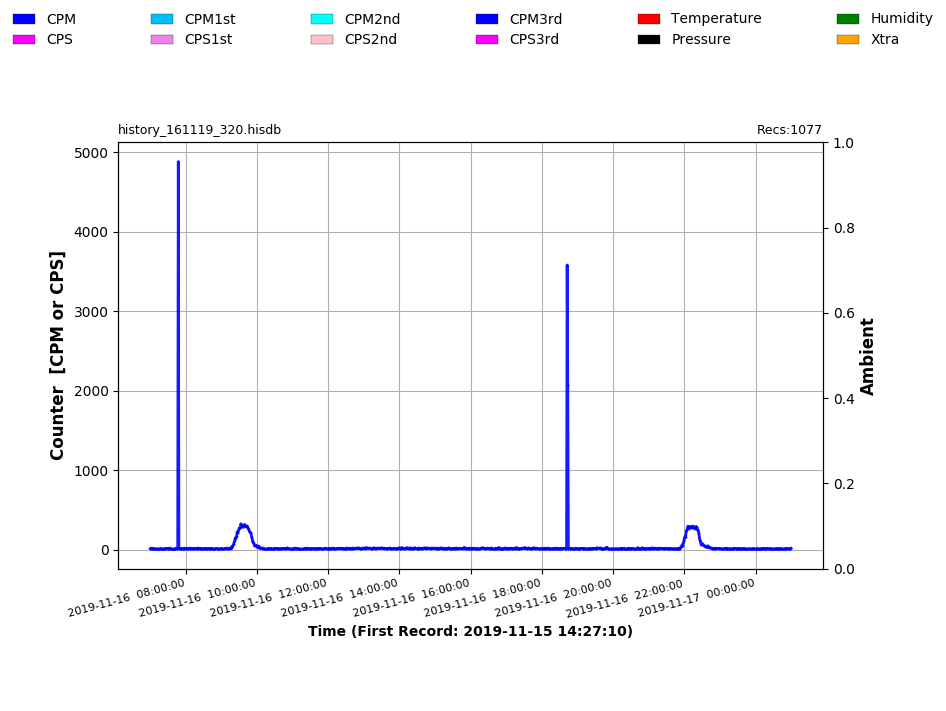
56667 bytes
GMC500:
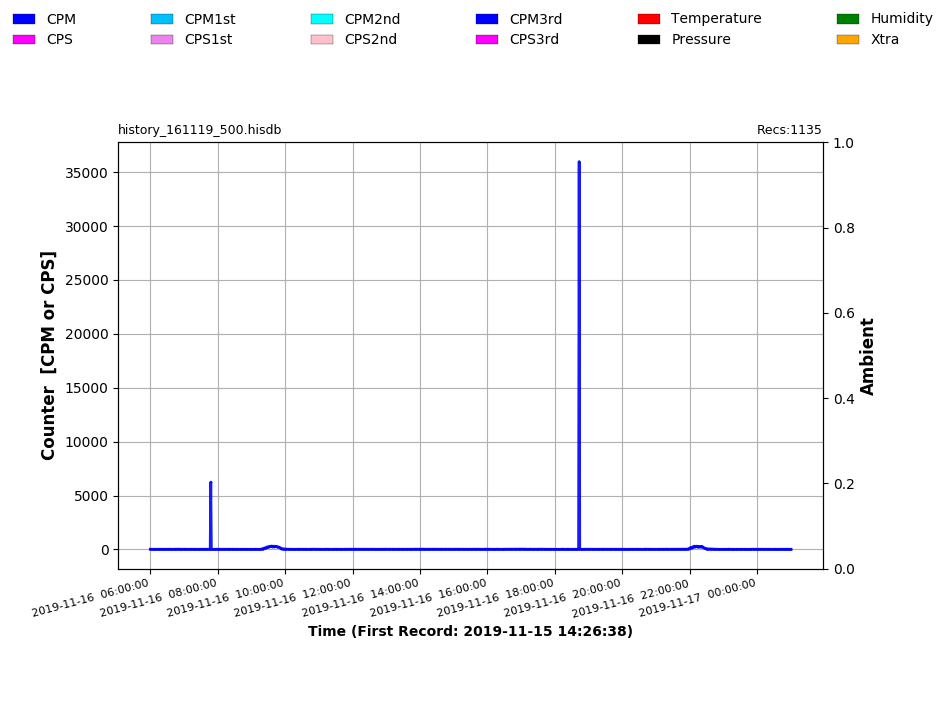
55329 bytes
I should have listened to Ullix, who recommended to set the History-Savingmode to CPS during security-checks to measure the used scan-energy.
Security-check at ZRH:
GMC320+:
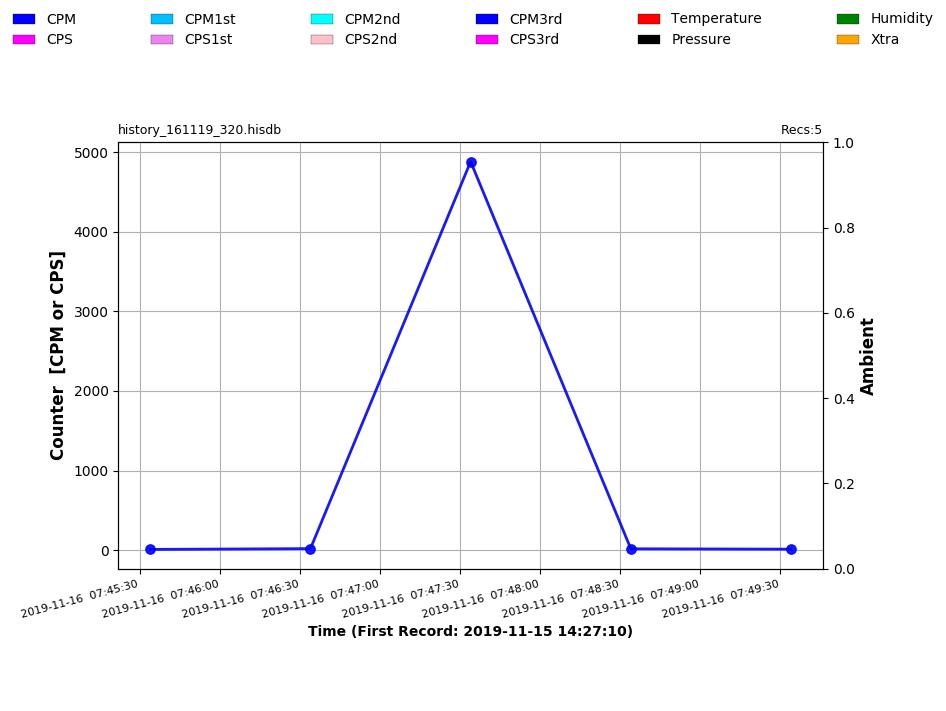
56364 bytes
GMC500:
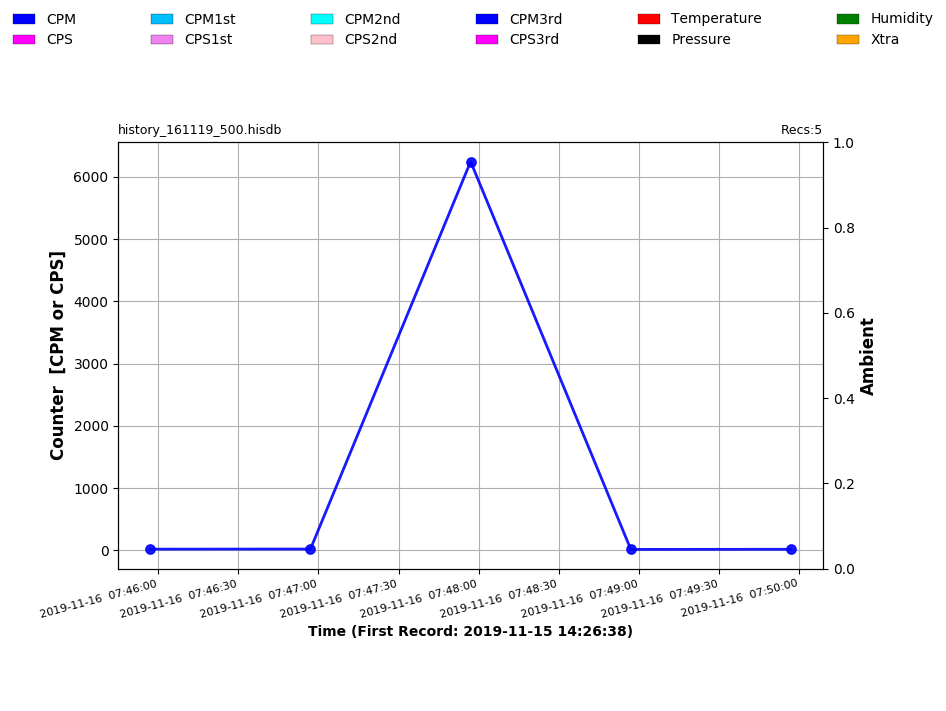
59720 bytes
The measurements of both counters are similar. Due to not setting the savingmode to CPS, a reliable assumption on the used energy can not be made. I contacted both airports to ask about the methods and used energy during the security-check, but didn’t get an answer yet.
The flight from ZRH to AMS:
GMC320+:
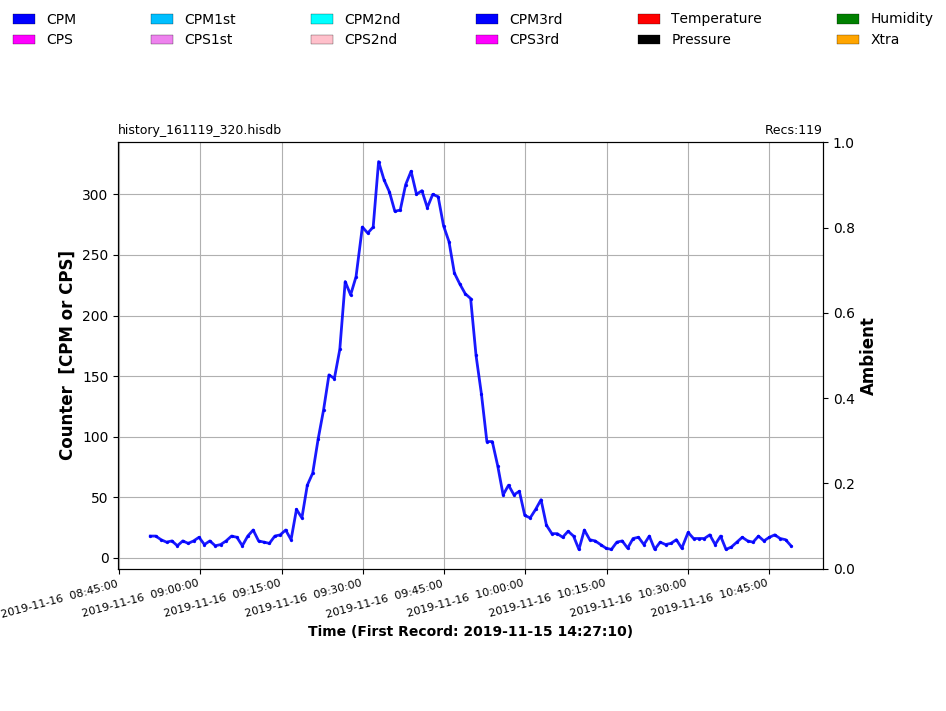
65122 bytes
GMC500:

65417 bytes
Boarding-time: 08:30 EST at the gate, Take-off from Runway 28 at 09:05 EST. Touchdown on Polderbaan at approx 10:20 EST.
Readings are similar, no special observations during the flight. Standard-approach at AMS.
Disembarking at approx. 10:40 on the airfield
Background in Amsterdam
According the Logs, Amsterdam has a similar background-radiation as Zurich/Thurgovia. Thus no special Log-Screenshots.
Security-check at AMS:
GMC320+:
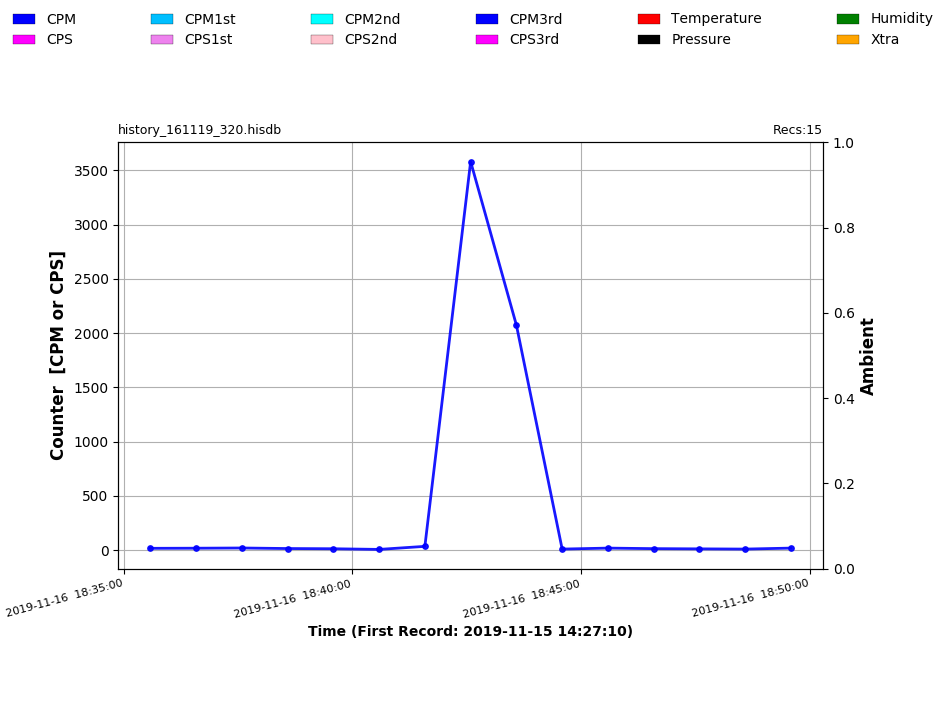
55300 bytes
GMC500:

54282 bytes
Observation:
the GMC320 doesn’t show a count as high as the GMC, but it shows two CPM-measure-points during the scan.
Best guess is, that the rucksack containing the counter has been scanned twice.
Security-Check at Department 2 in AMS’. According to AMS customer care, Dept.2 and Dept.3 are using new "3D-technology" aka computerthomographs for luggage, and the body-scanners (with the nice teta-radiation); in ZRH normal ("old") X-Ray-technology is used.
ZRH' customer care didn't answer my query about confirming the readings/giving me some more in-dept information about the scan-method.
Flight from AMS to ZRH:
GMC320+:

62680 bytes
GMC500:
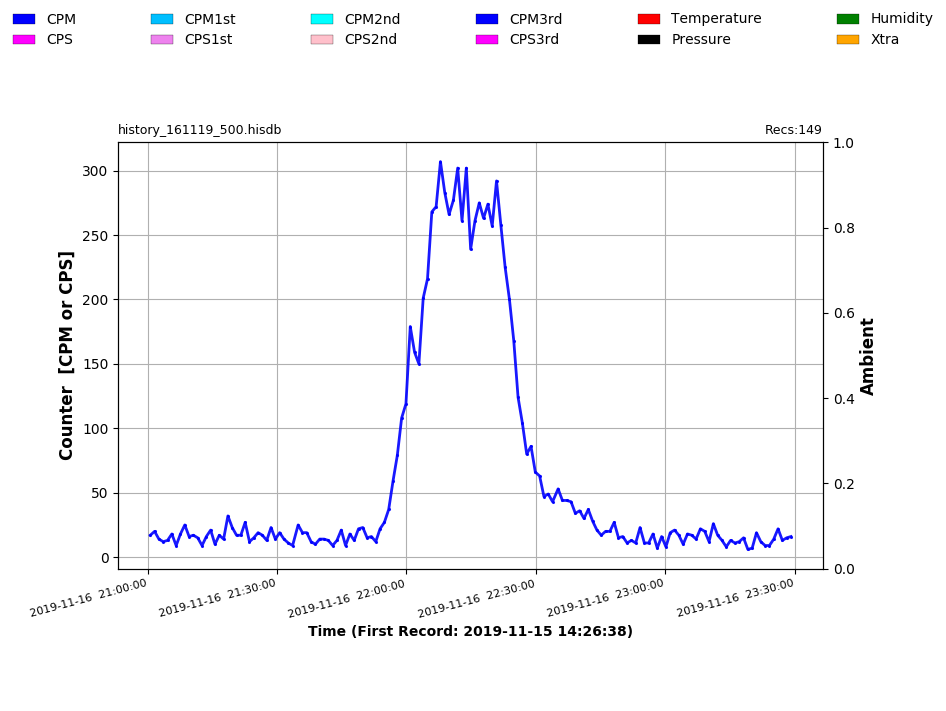
64160 bytes
Boarding-time 20:30 EST and 20:50 EST due to technical difficulties with the first plane. Take-off from Buitenveldertbaan 21:40 EST. Landing in ZRH at 22:50 on Runway 28. Disembarking at the Gate.
During the flight, approx. 30min after take-off, heavy turbulences occurred, the flight-level had to be adjusted to lower altitudes until arrival at ZRH.
|
| 33 L A T E S T R E P L I E S (Newest First) |
| Damien68 |
Posted - 12/20/2019 : 12:45:23
yes it is certainly the most adequate use, and which avoids draining the battery of the meter.
but if we had a Bluetooth connection, it would be even better, we could make a global log either in the meter or in the phone, including text messages easier to do, photos, voice messages or other media. also the air pressure which can be interesting
or as you say build 2 databases and merge them after |
| ullix |
Posted - 12/20/2019 : 02:54:18
I am probably as excited as everybody else on the ease of using GPS, in particular when built into a Geiger counter. But I am wondering: why should we even do this when basically everybody already has a GPS device at hand, i.e. the smartphone?
Would be nice to use the smartphone to load live data from the counter (via Bluetooth, WiFi), and merge the data with the GPS data. But that will take a while before this is possible.
What one can already do today is to record the GPS data in the phone, record the count data in the counter, and later merge the data.
I have installed the app 'GPS Logger' on my phone, which does the GPS logging. It produces records similar to this one:
T,2019-12-20 09:44:44,51.11111,6.66666,20,55.555,46.383,0.000,,7,42,,
There you have a date-time stamp, lat, lon, and alt (and some more info). And on your counter the record - as downloaded via GeigerLog - is:
Index, DateTime, CPM, CPS,
1602, 2019-12-20 11:31:30, 31.0, 2.0,
The time-stamps between the two records will never be the same, so to merge them you take a counter record, interpolate between two time-adjacent GPS records, and save the combined record.
If anyone offers such two records, I'll create the program!
|
| Damien68 |
Posted - 12/19/2019 : 09:26:20
I ordered a Sparkfun GTop TitanX1 breakboard from amazon.
I just received it, but in fact it is an XA1110 module from sierra which is on it, it's the same thing.
quickly tested with a USB -> Serial 3v3 FTDI cable for data and a 3v3 power supply, it is very good.
the first time it takes time to download all the constellation data via the GPS signal (satellites locations and their trajectories), after that it is very fast and precise more precise than the GPS on my phone (old Nexus 5X).
consumption is presently 24mA on average in normal mode (10Hz) with 4 covered satellites
I have not yet tested the low consumption mode (1Hz)
for indoor use, sometimes it has trouble receiving the signal but I think this is the case for all GPS receivers, it certainly depends on the position of the satellites coming and going and the strength of their signals
|
| Damien68 |
Posted - 12/16/2019 : 04:21:15
@ullix
you are right, sierra wireless markets the same module
See their specifications, XA series is with antenna, XM is without antenna.
https://www.sierrawireless.com/products-and-solutions/embedded-solutions/gnss-positioning-modules/
|
| ullix |
Posted - 12/16/2019 : 01:48:00
Looks like the original manufacturer, GlobalTop Technology, had given up this business:
quote:
GlobalTop Technology was one of the leading suppliers of embedded positioning modules worldwide, with more than a decade of expertise in GNSS module technology, and one of the most comprehensive GNSS portfolios in the industry. GlobalTop's GNSS Module Business unit was acquired by Sierra Wireless Inc. in April 2017.
https://www.linkedin.com/company/globaltop-technology
The acquirer is Sierra: https://www.sierrawireless.com/products-and-solutions/embedded-solutions/gnss-positioning-modules/
Though I don't see it broadly available.
|
| Damien68 |
Posted - 12/15/2019 : 03:05:40
@ullix,
the module you found looks good (12.5 x 12.5 x 6.8mm),
https://telematik-markt.de/telematik/ultrakompaktes-gpsglonass-modul-mit-integrierter-patch-antenne
complete datasheet of it: https://cdn.sparkfun.com/assets/parts/1/2/2/8/0/GlobalTop_Titan_X1_Datasheet.pdf
breakout board for 50 USD https://www.sparkfun.com/products/14414
or amazon:https://www.amazon.fr/gp/product/B077QHVJGG/ref=ox_sc_act_title_1
it has a patch antenna which must be more efficient than the antenna of my module, and it consumes less.
it's still a mediateck chip that's in it, the MT3333
h**p://www.airoha.com.tw/webe/html/pro/index.aspx?kind=80&num=132&lv=2
it has a quick start mode by keeping the constellation data and the time in memory, so it could be activated only in the event of alarms (CPS or CPM high).
But it have high current consumption in standby mode (1.5mA) so to desactivate it completly it require certainly a power switch and check isolation of I2C bus when power down. |
| Damien68 |
Posted - 12/10/2019 : 06:22:09
MT2503 can work with or without GPRS but without GPRS we could certainly find more adequate chips |
| Stargazer 40 |
Posted - 12/10/2019 : 04:54:43
So the MT2503 functions best with GPRS or doesn't function at all without it? |
| Damien68 |
Posted - 12/10/2019 : 04:05:57
The chip inside SIM868 module is the mediateck MT2503
it is hard to find but it is still found on the Chinese market for about 5 USD.
mediateck make very good chip with high level of integration that can be found everywhere for example single chip DVD players...
MT2503 is the chip used in tracking children's watches.
but if you do not use GPRS, it's sure SIM868 is a bolt. |
| Damien68 |
Posted - 12/09/2019 : 16:55:58
I write baloon sory i want to say about balun is a rf transfomer :) |
| EmfDev |
Posted - 12/09/2019 : 12:09:39
I asked support and said they'll have to check with our supplier. We have an extension board for the 520+ that connects to the 500PCB. And that board has all the other features like CO2/Temp/GPRS/GPS. |
| Stargazer 40 |
Posted - 12/09/2019 : 07:16:57
@EmfDef - So the PCB is current, but the firmware needs the adds we've developed over the last year or so? Also the GPS chip sounds like it might be end of life according to ullix's last post. If this is an add-on chip is it simply wired in or plugged into the current PCB? Thought being maybe it's time to reevaluate the 520 and 510 as to taking advantage of less expensive and more energy efficient GPS chip if one can be found that fits the current hardware constraints. |
| ullix |
Posted - 12/09/2019 : 02:18:11
So the SIM868 chip is in the 520s? I have seen suppliers offering it for under $10 in quantities, but also some saying it is "no longer in stock". End of life for the chip, perhaps.
If I understood you correctly, then this burst mode need for higher power can be a bit of a challenge. But this is for the GSM/GPRS part only. Not sure why I would want such on a Geiger counter. Perhaps for a weather balloon, to sample cosmic radiation, but that would be a very special situation.
|
| Damien68 |
Posted - 12/08/2019 : 10:36:33
@ullix,
Sim868 GPRS module mentioned by EmfDev, have a good GPS functions. but effectivly require 3v4 to 4v4 power supply. they designed their GPRS chip like that certainly because of the GPRS which must emit pulsed frames up to 2W, this require 3 or 4W powering pulses because of the chip yield. and they have to output the power after a balun which is 10v efficace (on 50 ohms line).
h**p://www.simcom.com/product/279-en.html
it is also one of the difficulties to design the schematique of powering 2G modems, is that we go from a current of a few milliamperes to a current of more 1 ampere in a few nano seconds and reciprocally. what needs special regulators otherwise it destabilizes them completely, in the case of the sim868, they certainly connected it directly on the battery because it supports more than 4v2 and it make for that.
yes the GPSDO is quite special, it allows to make very accurate frequency measurements for an affordable price, and without the need to install air conditioning to use calibrated laboratory equipment. it serves for example to check quartz calibration and very precisly what is interesting for the RF designs.
|
| ullix |
Posted - 12/08/2019 : 06:53:21
@Damien: The GPSDO sure looks like a very, very special instrument! But the ublox is interesting. The price point is approaching $10 for quantities. In Germany it is offered by Wetterott on a breakout board for 29€ https://shop.watterott.com/CAM-M8Q-Breakout-Multi-GNSS-Modul-GPS-QZSS-GLONASS-BeiDou-Galileo
I only found this one https://telematik-markt.de/telematik/ultrakompaktes-gpsglonass-modul-mit-integrierter-patch-antenne It was also released in 2017, but the company GlobalTop seems to have gone out of business already; web site down and alibaby out of stock.
@EmfDev: what GPS chip is used in GQ's 520 systems?
|
| Damien68 |
Posted - 12/07/2019 : 10:03:43
@ullix: I quickly looked at the digikey website about GPS receivers.
I was offered business related to the GPS, but for now it has remained in the preliminary state. you are certainly right, the amplified antennas are only when they are at the end of a cable (5m - 10m), certainly to compensate the cable losses and optimize the impedance matching strongly needed by cable usage.
Indeed I may have been a little fast by talking about amplification, in this case the amplification may be not required.
we can found a lot of USA chipset at digikey web store with differents sensibility but they remain quite expensive, we can see it with the following link:
https://www.digikey.com/products/en/rf-if-and-rfid/rf-receivers/870?k=gps
China module is not supplyed by European/American distributor but by aliexpress or others china sites.
Presently I have a GPSDO (GPS Disciplined Oscillator) is a 10MHz clock with 10-12 digits precision (10.000 000 000 MHz) . it usefull for frequency counter reference or calibration. it use the 1CPS GPS pulse based on atomic clock embedded in GPS satellites.
It use a marin GPS chip with amplified GPS antenna with 5m cable, Indoor it is less sensitive than the GPS of my phone, but it allows me to take the antenna outdoor, in this case, because the antenna is outdoor, we gain globally in sensitivity. This is usfull in case of a GPSDO or marin Navigation tools, with better precision (we can get more satellites), but for a GM device, indeed it's irrelevant to detach the antenna at the end of a cable.
Image Insert:
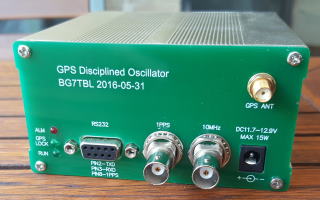
14068 bytes
for example this module (see below) seam to be easy to integrate because it have an embeded antenna, but backup battery voltage is limited to 3v6 and can't be directly racorded to LiOn batt voltage
and is not a I2C interface but a full compatible I2C interface and device can strech the clock regarding of his own interrupt (like a buzzy state). it's the kind of thing requiring to can be managed by host CPU. also it is not necessarily the best module but it's an example
Image Insert:
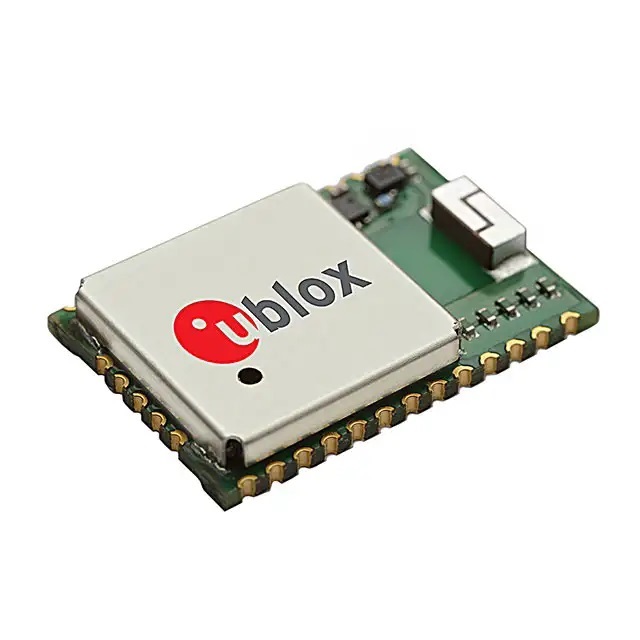
49062 bytes
https://www.u-blox.com/sites/default/files/CAM-M8-FW3_DataSheet_%28UBX-15031574%29.pdf
|
| ullix |
Posted - 12/07/2019 : 02:56:38
@Damien: since you seem to have gathered some market insight, can you name or even recommend GPS chipsets, which use the I2C communication protocol?
Regarding the antenna: since it consumes a significant amount of current, what is their benefit? Looking at today's breed of smartphones, they all do quite well with their GPS, without using an external antenna?
I have a marine GPS, which I do use with an external antenna, but simply because I can handle the device down below in a sail chip in a protected area, while the antenna may be at a rougher spot. I really never observed better reception with the antenna (but then being on a big body of water provides you almost always with good reception conditions anyway.)
|
| Damien68 |
Posted - 12/06/2019 : 12:09:51
for 2500mAh 18650 Li-On battery, 100mA represent 0.04C (0.04 x his capacity), so decharge curve is better than the black one on the picture bellow:
Image Insert:
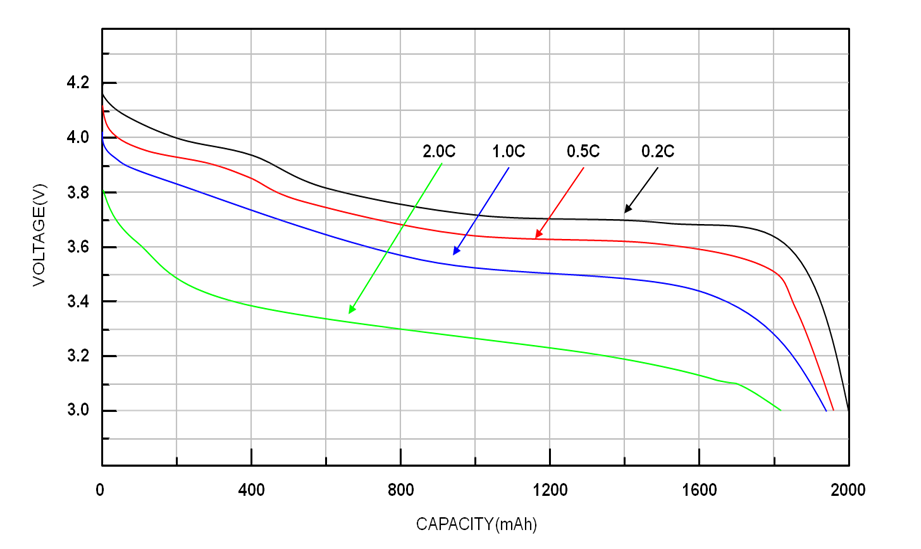
67026 bytes
https://www.richtek.com/battery-management/en/designing-liion.html
So 3v3 is realy near to the battery end of charge. counter can auto switch off at this voltage or warm up.
with only one battery i think is enough, with about 1 day autonomous with full options on.
|
| EmfDev |
Posted - 12/06/2019 : 10:03:35
The average consumption on the 520+ with everything turned on is about 100mA/h. You can turn off other features like GPS/GPRS/CO2 or you can turn all of them at once. The GPRS module stops working at below about 3.3V. It is using Sim868 chip.
@stargazer_40 the PCB is the latest one same as the latest 500+ PCB. But software hasn't caught up yet. It supports everything before and including the Auto Voltage. |
| Damien68 |
Posted - 12/06/2019 : 07:37:18
I quickly looked out by curiosity, GPS chipsets on market consume 20mA (average) in active mode (tracking / aquisition), there are some that have eco modes that consume less by making one acquisition per second. but basicaly it takes 20mA. if you put an active antenna for better GPS reception, you need 18mA more. total current is so 38mA for GPS function.
The GPS alone should fully discharge a battery LiOn 18650 (2500 mAh) like those of the 500+ in 2.5 days.
but coupled to the accelerometer there should be a way to save partialy the battery current by activating the GPS only when when it's needed.
for a CO2 sensor, it takes another 40mA, after that depends on what sensor is used.
There may be too many sensors on the 510/520. but it could still be very interesting, it would be necessary to can enable or disable the sensors easily and at the same time have an estimate of the battery remaining life time. So user can activate special fonction when he want/need it, It would be perfect. but to get an accurate estimate of the remaining battery time, normally it requires a 'fuel gauge', it's what's in the smartphone, it measures permanently and integrates the battery current flow (charge/decharge).
|
| Stargazer 40 |
Posted - 12/06/2019 : 05:35:33
Battery drain remains a serious concern. The cases for the 510 and 520 have room for additional battery in parallel, but there may be problem with charging circuits to support. Asked support about this before and it is being investigated.
Not so important to me to transmit data, only real time display and collect for later analysis. I do like the idea of GPS in the meter. Perhaps EmfDev can comment on applicability of the latest firmware upgrades to the 510 and 520 meters (would they have to be upgraded from something much earlier and what about PCB level). |
| ullix |
Posted - 12/05/2019 : 23:43:00
Indeed, I am not interested in any 2g,3g,4g,5g. Wifi (or Bluetooth) will do. GPS is indeed something extra with some value in it. (But I guess it will be slurping through the battery?) |
| Damien68 |
Posted - 12/05/2019 : 07:08:22
the GPRS (2G modem) is really old, has the fact that it sends RF burst quite violent (30dBm pulsed RF output) (is more than 3G or 4G), the chips are realy not expensive.
But it is the only one that is really standard in having to support only two standards very neighbors (one for North America and another for the rest of the world). This usually requires simply adapting the antenna accordingly (or having a dual band antenna).
I had business to integrate 3G or 4G modem, it amazing but it needs to be adapted for every region of the world and sometimes from one operator to another one it requires adaptations. to say that unless you have large sales volumes, it's unmanageable.
also the 2G is the current standard for low flow like medical devices or others.
I say that to come to the following thing: the operators at least in Europe have all wanted to cut the 2G to place the 4G on optimal frequencies, at home, two years ago, it was cut for 6 months and then it has been reconnected.
So the big question is, what is the perenniality of 2G (GPRS)? everyone uses it but I have the impression that no operator has any commitment to maintain it.
also the GPRS or other mobile standard is a source of annoyances.
So I do not know what will give the 5G :) or if it will give something, but meanwhile the most standard is still the Wifi. In fact the ideal could be simply wifi like the 500+ with just the GPS added |
| ullix |
Posted - 12/05/2019 : 03:17:42
I agree, keeping the "new" devices only on the "old" store site is a great way to keep those pesky customers away! Or is there a reason for not marketing this new device more intensively? Everything always working as expected or have some problems surfaced?
Re the GPS commands: can you be a bit more specific? Like what options can be send with the command, and what are the responses, and how do they need to be interpreted?
And what are the AT commands you think need to be sent?
|
| EmfDev |
Posted - 12/03/2019 : 09:52:26
@ullix and @Damien68, it does also give information about the altitude. I think it will be available in amazon soon but I'm not sure how long. It's not new, it's been up in the old website for a while. You can send text message to it like <GETGPS>> to get the gps info. There is a command to send AT commands for the GPS/GPRS I think. |
| Damien68 |
Posted - 12/03/2019 : 07:06:57
@ullix
I find it with Google:
https://www.gqelectronicsllc.com/comersus/store/comersus_viewItem.asp?idProduct=5673
or available in the 'old' store not 'new store' |
| ullix |
Posted - 12/03/2019 : 05:38:45
@EmfDev: the claimed "510/520/520+ with GPS" are nowhere to be seen in your "New store", so are they really available?
However, if they can't offer altitude readings. their value would be much reduced?
No problem to implement at least the readout in GeigerLog, but you'd have to provide the commands for readout?
You should offer a reward for the first one to present long-distance flight (> 4h) data with combined lat, lon, alt, and CPM+CPS! |
| Damien68 |
Posted - 12/02/2019 : 13:50:15
the 510 seems brand new not yet on Amazon.
also with a thermometer which can be good for a dynamic calibration of the tubes.
for GPS, we do not see the altitude?
GPS + GPRS = GPS Tracker (2G) it may interest some people.
It seems a good product well thought out. |
| EmfDev |
Posted - 12/02/2019 : 11:14:43
Hi the_mike, we have GPS on the 510/520/520+ and it saves the GPS value to the memory every 3 minutes when it gets a fixed position. |
| the_mike |
Posted - 12/01/2019 : 05:54:31
Yeah, the GPS-logger.
An interesting idea, only to see the flightroute (other than checking online-portals who record, but only for a certain timeframe)...
I'll take all (incl. the "switch to CPS") advices into consideration the next time I'll fly!
And you're right - it realy is amazing what these little tools can do!
@EmfDev
...maybe a good idea: what about GPS-sensors for the GMC, recording/logging the location next to the counts? (maybe as USB-extension, with additional storage, GPS-logger, Realtimeclock (with sync-capability to the GMC) and maybe an additional battery (as in "a batterypack with extensions" for the GMC)? |
| ullix |
Posted - 11/29/2019 : 01:12:24
I am always amazed what you can do with a device that is technically as trivial as a Geiger counter is. Combine this with some processing and storage capacity inside the counter, and some software outside, and you can produce some great inside into nature.
So far I have seen quite a few flight recordings with Geiger counters, and so far they were all with GQ counters. The lowest cost device of them will do, and produce outcomes that still excites me. I can only encourage people to take a counter on their next trip, and show the data here.
What is missing here is GPS information, both on latitude, longitude, but not the least on height. One can handle a smartphone in parallel - if you hold the smartphone flat at the airplane window, you do get a GPS signal at least most of the times. Amazing to see the speed when you you use the app, you would normally use in a car ;-). The data would have to be manually combined with the the Geiger data; possible but cumbersome.
Already you can derive the flight profile from the counter data. I would assume that count rate is linear with flight altitude, but only some GPS based experiments will really tell.
Looking at the data I think what also is missing is the exact time of start - lifting the tires from the tarmac - and time of landing - touching the tarmac with the tires. These should be manually recorded.
Looking forward to some future data displays.
|
| the_mike |
Posted - 11/28/2019 : 12:45:12
Yes, happened during the security-check in AMS (the "3d scanner"); best guess is the 500 having the scan in "one CPM cycle", while the 320+ had it in two...
Unfortunatly, AMS customer-care doesn't want or mustn't give me details about the energy used scanning the handluggage to see which counter's measurement is closer to the real one... |
| EmfDev |
Posted - 11/27/2019 : 10:51:40
That is a lot of difference between the CPM. Did I see it correctly? the 320+ has a peek of ~3500 and the 500 is at 35000 CPM? |
|
|

